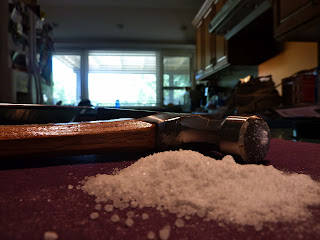Physical Properties
Each of the following properties listed are physical properties because I did not change the chemical ID of the substance to discover the facts.
Color
To begin, I decided I would try to determine the color of said Epsom Salts. It was quite the difficult task. It involved opening the carton and looking at it. Very tough. But after careful consideration that looked a lot like this:
I realized that epsom salt was, in fact, white. It also did have a transparent quality as well. Neat-o.
Phase
Next, I needed to discern the phase of the salt. After centuries of this:
I came to the conclusion that it was a solid (as it was defined by having both a definitive shape and volume).
Malleable
Malleability is the ability to be hammered into thin sheets. So naturally I picked this property to try because it sounded like fun. This is what it looked like (be afraid):
But much to my dismay (and my mother's delight), epsom salt is not malleable. It just broke down into smaller grains, like so:
Bummer. So it's safe to say that malleability is not a physical property of epsom salt.
Solubility
AH! One of my favorites. I put about a half cup of the salt into about a half cup of water. Interestingly enough, the result was this:
As we can see, after stirring the mixture, it separated. Upon closer inspection, we can see that the crystals have lost their milky hue (which is now tainting the water). The compound that is epsom salts (magnesium sulfate) does not completely dissolve in water. In a later property, I shall explain what has happened.
Taste
Oh, God. This one was NASTY. Every tried tasting magnesium sulfate? I do NOT recommend it. So after letting one crystal dissolve on my tongue and was disgusted, I delegated the task:
The Original Chemistry Cat
She was not impressed. The salt had a bitter taste. It was gross. But I digress. I just need to communicate how positively revolting it was.
Chemical Properties
Each of the following properties listed are chemical properties because I did have to change the chemical ID of the substance to discover the facts.
Flammability
One of my personal favorites. This required safety goggles and adult supervision (two of my least favorite things... the sacrifices I make for science). I dumped a pile of the salt on the ground and stuck a match. It was just as neanderthal as it sounds, and it looked like this:
Pretty Snazzy, no?
Despite the annoying wind that kept blowing out the flame, I managed to block it for long enough to know that no amount of prodding will end in a bonfire. Disappointed, I blew out the match and shuffled back inside, where I discovered five mosquito bites. Not only did I not get the explosion of inferno that I dreamed of, I had to set back my schedule to treat my wounds. Epsom salt is not flammable... darn.
Reactivity of Acid
At the request of our teacher, we were not allowed to break open a battery and pour it on the substance. But I made do with vinegar. So I put a half cup of epsom salt in a cup and poured in enough vinegar to drown a bat. Again, no furious explosion, nothing. Sad, really. It just did this:
Big, Fat, NOTHING!
So it is safe to say that epsom salt does NOT react with acid. So what does it do? Which brings me to...
The pH Balance
Not exactly the most exciting, but whatever. Since I didn't have any means to conduct this test on my own, I used the magical world wide web. According to W Chemicals Online (http://w-chemicals.com/properties-of-magnesium-sulfate/) the pH balance of magnesium sulfate is 6.0. Neither an acid or a base, right in the middle. The pH balance of a solution is the measure of how much hydrogen is in a given substance. In order to gain this information, we must change the chemical ID of the substance, thus it is a chemical property.
Upon Heating
According to W Chemicals Online (http://w-chemicals.com/properties-of-magnesium-sulfate/), when magnesium sulfate is heated at over 250 degrees Celsius, epsom salt is broken down into magnesium oxide. Which changes the chemical ID of the substance. Which makes it a chemical property. TADAA!
Transfer of Energy
In my personal opinion, this is the coolest. First, I put a half cup of lukewarm water in a jar. My dad happened to have a temperature probe. The water was 26.6 degrees Celsius.
After, I added a half cup of epsom salt. I stirred it until the water had broken the substance down into two ions: magnesium and sulfate (thus changing the chemical ID). The energy it took to make this change lowered the temperature. The second measurement of heat (after the salt was added) was 22.2 degrees Celsius. This was an endothermic reaction. Cool, no?
This concludes today's chemistry lesson. Thank you and good night.











